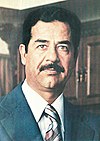1979 Ba'ath Party Purge
The 1979 Ba'ath Party Purge was a public purge of the Iraqi Ba'ath Party orchestrated on July 22, 1979 by then-president Saddam Hussein.
Background[]
Earlier in 1979, Iraqi president and chairman of the Revolutionary Command Council (RCC) Ahmed Hassan al-Bakr had begun to make treaties with Syria, also under Ba'athist leadership, that would lead to the unification of the two countries. Syrian president Hafez al-Assad would become deputy leader of the union, and this would drive Saddam Hussein and his Sunni clique into obscurity. Saddam acted to secure his grip on power. The ailing al-Bakr resigned on July 16 under the threat of force, and formally transferred the presidency and chairmanship of the RCC to the "cherished comrade Saddam Hussein". RCC secretary objected to the transfer of power.
Event[]
| External video | |
|---|---|
Saddam hurriedly convened an assembly of party leaders on July 22. During the assembly, which he ordered to be videotaped,[1] he claimed to have uncovered a fifth column within the party. Abdel-Hussein, broken after days of physical torture and under the threat of his family's execution, confessed to taking a leading role in a Syrian-backed plot against the Iraqi government and gave the names of 68 alleged co-conspirators. These were removed from the room one by one as their names were called and taken into custody. After the list was read, Saddam congratulated those still seated in the room for their past and future loyalty. Those arrested at the meeting were subsequently tried together and found guilty of treason. Twenty-two men, including five members of the Revolutionary Command Council,[2] were sentenced to execution. Those spared were given weapons and directed to execute their comrades.[3][4]
Some of the victims are listed below:
| Name | Position |
|---|---|
| Muhyi Abdul-Hussein | Member of the Regional Command from 1974 to 1979 Secretary of president Ahmed Hassan al-Bakr. |
Aftermath[]
By August 1, hundreds of high-ranking Ba'ath Party members had been executed. On August 8, the Iraqi News Agency announced that twenty-one of the twenty-two Iraqis were executed by firing squad for "their part in a plot to overthrow Iraq's new president". The twenty-second man was condemned to death in absentia because he was "nowhere to be found", the agency said.[2] A tape of the assembly and of the executions was distributed throughout the country. "On an August afternoon in 1979, his face tense and somber, Saddam Hussein from the balcony of the presidential palace in Baghdad "informed a chanting crowd of 50,000 supporters "that he had just witnessed the punishment the state court had ordered for 21 of those men: They had been executed by a firing squad. The crowd cheered".[5]
References[]
- ^ A Documentary on Saddam Hussein 5 on YouTube
- ^ a b "Iraq executes coup plotters". The Salina Journal. August 8, 1979. p. 12. Retrieved April 25, 2018 – via Newspapers.com.

- ^ Bay Fang. "When Saddam ruled the day." U.S. News & World Report. 11 July 2004. Archived 16 January 2014 at the Wayback Machine
- ^ Edward Mortimer. "The Thief of Baghdad." New York Review of Books. 27 September 1990, citing Fuad Matar. Saddam Hussein: A Biography. Highlight. 1990. Archived 23 July 2008 at the Wayback Machine
- ^ BEHIND IRAQ'S BOLD BID, by Claudia Wright, 26 October 1980, The New York Times.
- 1970s coups d'état and coup attempts
- 1979 in Iraq
- History of the Ba'ath Party
- Military coups in Iraq
- Political and cultural purges
- Political history of Iraq
- Political repression in Iraq
- Saddam Hussein
